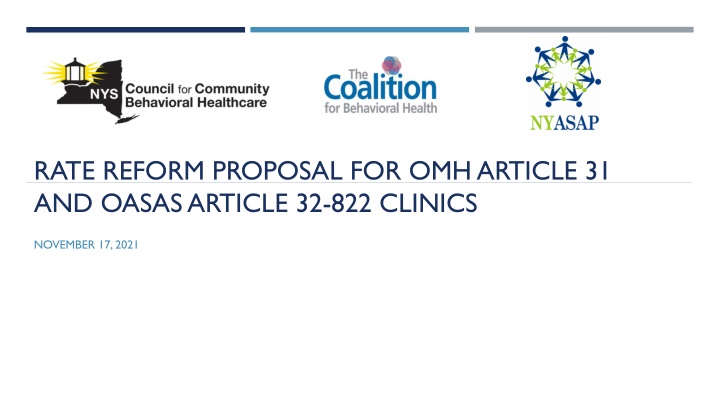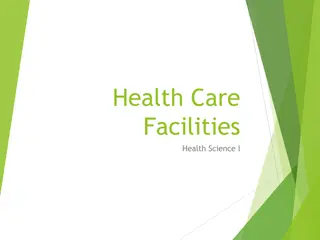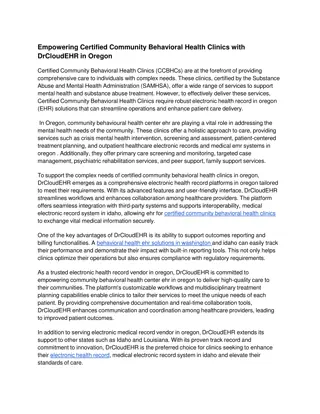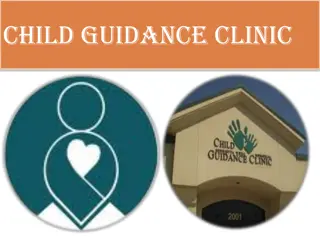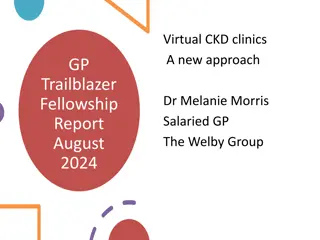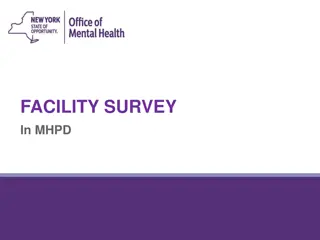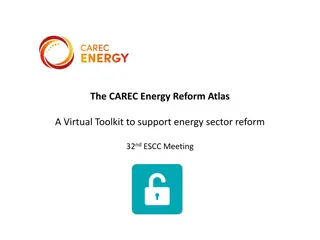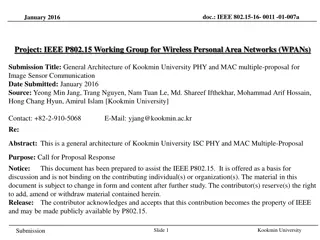RATE REFORM PROPOSAL FOR OMH ARTICLE 31 AND OASAS ARTICLE 32-822 CLINICS
Underfunded outpatient clinics, increasing suicide rates, escalating drug overdose deaths, and shrinking budget share for behavioral health care are key challenges faced in New York. The demand for services is outpacing capacity, hindering access to critical care. Comprehensive reforms are needed to bridge gaps and improve outcomes for historically underserved communities.
Download Presentation

Please find below an Image/Link to download the presentation.
The content on the website is provided AS IS for your information and personal use only. It may not be sold, licensed, or shared on other websites without obtaining consent from the author.If you encounter any issues during the download, it is possible that the publisher has removed the file from their server.
You are allowed to download the files provided on this website for personal or commercial use, subject to the condition that they are used lawfully. All files are the property of their respective owners.
The content on the website is provided AS IS for your information and personal use only. It may not be sold, licensed, or shared on other websites without obtaining consent from the author.
E N D
Presentation Transcript
RATE REFORM PROPOSAL FOR OMH ARTICLE 31 AND OASAS ARTICLE 32-822 CLINICS NOVEMBER 17, 2021
THE PROBLEM Underfunded Article 31 and Article 32 (822) outpatient clinics Rates that fail to keep pace with inflation No payment for essential parts of the service No payment for capital costs Inequitable service availability leads to inequitable outcomes for historically underserved communities Shrinking capacity as clinics close Skyrocketing demand resulting from the pandemic Administrative complexity detracts from program quality COVID-19 exacerbated an already problematic capacity problem by spiking demand for BH care
Suicide Rate in New York State (per 100,000) 10 9 8 7 6 SUICIDE RATE IS INCREASING 5 4 3 2 1 0 2000 2001 2002 2003 2004 2005 2006 2007 2008 2009 2010 2011 2012 2013 2014 2015 2016 2017 2018 https://www.health.ny.gov/statistics/prevention/injury_prevention/suicide_selfinflicted.htm
All Drug Overdose Death Rates per 100,000 Population (Age-Adjusted) in New York 30 25 20 OVERDOSE RATE IS INCREASING 15 10 5 0 1999 2000 2001 2002 2003 2004 2005 2006 2007 2008 2009 2010 2011 2012 2013 2014 2015 2016 2017 2018 2019 2020 https://www.kff.org/other/state-indicator/opioid-overdose-death-rates for 1999 through 2019. 2020 calculated using data from NYS - County Opioid Quarterly Report Published July, 2021 and https://www.census.gov/library/stories/state-by-state/new-york-population-change-between-census-decade.html
THE BEHAVIORAL HEALTH SHARE OF THE NYS HEALTHCARE BUDGET IS SHRINKING 100% 90% 80% 70% 60% 50% 40% 30% 20% 10% 0% 1996 2019 1995 1997 1998 1999 2000 2001 2002 2003 2004 2005 2006 2007 2008 2009 2010 2011 2012 2013 2014 2015 2016 2017 2018 2020 2021 DOH OMH OASAS https://openbudget.ny.gov/ - data originally collected for NYSCCBH in 2019 and updated for this project
CAPACITY IS NOT KEEPING PACE WITH INCREASED DEMAND Long Island New York City Hudson River Region Central Region Western Region -10.00% 0.00% 10.00% 20.00% 30.00% 40.00% 50.00% Demand change between 2013 and 2019 Capacity change between 2013 and 2019 OMH Tableau Visualizations
BH PROVIDER REIMBURSEMENTS DO NOT COVER THEIR COSTS Moving a portion of the BH provider community to a cost-based reimbursement methodology led to an increase in rate of over 74%, demonstrating conclusively that providers have been consistently reimbursed below cost. Non-CCBHC rate CCBHC cost-based rate Total non-CCBHC visits 6,031,270 Total CCBHC visits 538,628 Total non-CCBHC spend $772,993,741 Total CCBHC spend $120,246,715 Avg. non-CCBHC visit cost $128.16 Avg. CCBHC visit cost $223.25 https://omh.ny.gov/omhweb/tableau/county-profiles.html
COMMUNITY BEHAVIORAL HEALTH PROVIDERS ARE FINANCIALLY DISTRESSED The average provider had less than three weeks of cash on hand (18.4 days) o A quarter of providers had less than one week of cash on hand (5.8 days) o Only 20% had over two months of cash on hand o Including non-liquid investments only brought the average cash on hand to 40 days. 30% of providers had a quick ratio of less than one, indicating that they are likely to have difficulty paying their current obligations for the coming year The median provider had earnings before interest, depreciation and amortization (EBIDA) of less than 4% o Nearly a quarter of providers had EBIDA of less than 1% o 10% of providers had negative EBIDA 40% of providers had a total margin of zero or less o More than a quarter of providers had a negative margin in 2019 o The average provider had a total margin of only 1.2% Based on an analysis of 143 NY Non-Profit BH providers 2019 forms 990
MEMBERSHIP ASSOCIATION COLLABORATION New York State Council for Community Behavioral Healthcare, The Coalition for Behavioral Health, and the New York Association of Alcoholism and Substance Abuse Providers came together to address this question collaboratively Convened a workgroup of 17 member organizations Five 90-minute planning and strategizing sessions facilitated by HMA Began with a broad range of options and worked to find consensus on a proposed model
WORKGROUP MEMBERS Ron Acker, The Jewish Board Rosa Gil, Comunilife Ron Colavito, Access: Supports for Living Leon Greene, Child Center of New York Lauri Cole, NYS Council for Community Behavioral Healthcare Elliott Klein, New York Psychotherapy and Counseling Center Anne Constantino, Horizon Health Jeremy Klemanski, Helio Health John Coppola, New York Association of Alcoholism and Substance Abuse Providers Karyn Krampitz, New York Psychotherapy and Counseling Center David LePage, Behavioral Health Services North Erin DiGirolamo, Horizon Health Services Nancy Manigat, CN Guidance and Counseling Services Steve Donowitz, Child Center of New York Charlotte Ostman, The Mental Health Association of Westchester Amy Dorin, The Coalition for Behavioral Health Debbie Pantin, Outreach Debbian Fletcher-Blake, VIP Community Services Robert Ross, St. Joe s Addiction Treatment and Recovery Centers Ann Marie Foster, Phoenix Houses of NY/LI Valerie Walters, Lower Eastside Service Center
WORKGROUP PRINCIPLES Administrative Simplification: Make the way we bill and get paid less complex, less time intensive, less expensive, and more predictable Trend Factor: Payments must account for inflation and growth in fixed/overhead cost Capital Costs: Payments must cover the cost of maintaining healthcare facilities in accordance with state regulation, quality of care, and workplace safety Workforce: Payments must be designed to support a strong, growing, and capable workforce of qualified, tenured, and specialized providers Severity/Complexity: Payments should reflect the severity/complexity of the clients we serve Quality: Payments must be linked to quality outcomes and improvements for the populations we serve Parity Across Provider Types: The payment model must support solvency for the diverse Art 31/Art 31-822 outpatient BH providers across the State Upper Payment Limit/Regulatory Considerations: We cannot pierce the UPL and the model must be feasible within the regulatory structure of New York s Medicaid program Access/Coordination: Payment model must support statewide access to, and coordination of, services for residents of New York with BH conditions Consistent with Medicaid Reform: The payment model should be directionally consistent with the State s Medicaid reform priorities, including the upcoming 1115 waiver and goals around VBP
THE CHALLENGE New York State is up against the Upper Payment Limit for community outpatient BH providers Federal cap limits the ability of the state to increase rates Without additional money, things will not improve for outpatient BH clinic providers or their clients Replacing APGs would be a very heavy lift and would strain the administrative operations of providers
THE PROPOSAL Trended APGs
TRENDED APG Add a trend factor adjustment that increases along with the UPL cap Trended APGs Regulate MCOs to require them to harmonize their billing processes Proposal 2021 CPI-U Rate 2019 Medicaid Expenditure $745,690,501 Expenditure with Trend Factor $785,957,788 Investment Trend with CPI-U 5.40% $40,541,506
IF FORMULATED CORRECTLY, MCO DIRECTED PAYMENTS DO NOT COUNT AGAINST THE UPPER PAYMENT LIMIT Ensuring MCO directed payments work for providers No MCO-directed/determined attribution methodology No Utilization Management or Medical Necessity review or other validation exercise to determine level or appropriateness of payment State to set eligibility criteria and performance criteria Set up as a directed payment program w/admin add-on for MCOs Examples to model: Hospital VBP-QIP, Wage Parity Programs Any funds remaining, not distributed to providers would go back to the State and would not remain with the MCO
SOCIAL DRIVERS OF HEALTH COORDINATION AND INTEGRATION FEE Accounts for time spent beyond the current billable visit Applies to every visit for every Medicaid client Used to coordinate care with other providers and care managers SDH Coordination and Integration Fee This work is outside the scope of current billable rates, and is therefore an unfunded mandate if BH providers are expected to provide this service to their clients
CALCULATING THE SDH COORDINATION AND INTEGRATION FEE Calculating the fee Total non-CCBHC visits Total non-CCBHC spend Avg. non-CCBHC visit cost 25% of the average visit cost Calculating the total OMH A31 visits (2019) OASAS A32-822 visits (2019) Total BH clinic visits SDHCIF per visit Investment 5,205,919 1,405,295 6,611,214 $32.04 $211,830,470 6,072,586 $778,071,878 $128.16 $32.04
QUALITY ADD-ON Aligns to existing HEDIS metrics for both adults and children Complements (does not replace) existing PSYCKES project Glidepath provider pool for entry-level agencies, benchmark provider pool, and performance-driven pool for advanced providers based on performance against metrics Quarterly reconciliation Quality Add- On
BH QUALITY IMPROVEMENT PROGRAM Licensed outpatient clinics would be evaluated on their quality performance to determine performance driven add-on Quality Improvement Program (BH-QIP) payments. MMCs and HARPs would enter into agreements with OMH and OASAS outpatient clinics to provide directed payments based on standardized attainment thresholds for HEDIS and equity metrics. Providers would be held responsible for metrics that align to the population they serve (e.g. Children vs Adult) and would be compared to peer providers. Providers would be assigned to one of three performance pools. Performance Pools High Achieving Providers (Providers with advanced performance capabilities) Benchmark Providers (Providers who achieve the benchmark standard of performance) Glidepath Provider (Providers making progress for the population they treat as they work to achieve benchmark performance standards) BH-QIP Pool = 5% of total APG reimbursement to licensed outpatient clinics: $39,565,507
TOTAL ASK FOR 2022 APG Trend: $40.5m $211.8m $39.6m SDH Coordination and Integration Fee: Quality Add-On: Total: $291.9m
